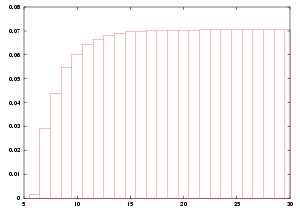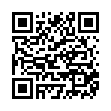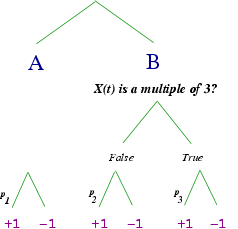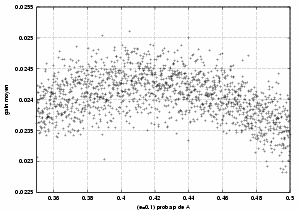/ Main Page / Probability /Parrondo's paradox
Parrondo's Paradox
A paradox?
The physicist Juan M.R. Parrondo is the inventor of the paradox of the same name. One will find an English talk on his personal page.
This is a relatively complex game presented as a succession of throws of not balanced coins. It is the combination
of play A, simple throw of a coin #1, and play B where one lance either the coin #2 or the coin #3:
A is a throw of a coin where Head is winnning with the probability p1=1/2-e, the gain is then of 1 euro. Tail is a loss (of 1 euro) with the probability 1-p1=1/2+e .
B is a little more complicated, if the capital is a multiple of 3, then Head wins with the probability p3= 1/10-e, if not Head wins with the probability p2=3/4-e, (gain or loss of 1 euro).
Wen e = 0, the play A, alone, is fair. The play B become fair when the n of plays tends to infinity. (Click on 'calculate A' or on 'calculate B').
A and B, alone, are lose when e > 0.
Click on 'simule A' or on 'simule B' to begin simulations.
The almost exact values (the rounding errors are often inevitable), are obtained then by clicking the button [ Calculates ]
When one uses combinations repeated like (AABB)+ or
(AAABBAB)+, one observes that the game
becomes gaining for certain these combinations, which can seem against-intuitive!
Obviously the play is paradoxical only seemingly, the results observed are calculated easily and the 'paradox' is explained by the no-commutativity of the product of certain matrix (of transition).
Who would think of finding paradoxical that a matrix product M×N is different from N×M?
One can conceive easily besides other plays, simpler, having the same type of behavior [EZ].
Simulations :
AAAAA,
AAAAB,
AAABB,
AABAB,
AABBB,
ABABB,
ABBBB,
BBBBB
Simulations : AAAAAA, AAAAAB, AAAABB, AAABAB, AABAAB, AAABBB, AABBAB, ABBAAB, AABBBB, ABABBB, ABBABB, ABBBBB BBBBBB
Reiterated Fibonacci's words, (calculus) : BA, BAB, BABBA, BABBABAB, BABBABABBABBA, BABBABABBABBABABBABAB BABBABABBABBABABBABABBABBABABBABBA
 Page personnelle de Juan M.R. Parrondo
Page personnelle de Juan M.R. Parrondo
 Brownian Ratchets, Parrondo's Games and more... Greg Harmer - Two games with unusual properties were originally devised by Prof. Juan MR Parrondo as a pedagogical example of a Brownian ratchet.
Brownian Ratchets, Parrondo's Games and more... Greg Harmer - Two games with unusual properties were originally devised by Prof. Juan MR Parrondo as a pedagogical example of a Brownian ratchet.
 Parrondo's Paradox Dan Vellerman and Stan Wagon. Two losing games can combine into a winning game. wagon93.nb (317.8 KB) - Mathematica Notebook
Parrondo's Paradox Dan Vellerman and Stan Wagon. Two losing games can combine into a winning game. wagon93.nb (317.8 KB) - Mathematica Notebook
 Etats d'A M E - Le paradoxe de Parrondo Journal de l'Association des Mathématiciens de l'École Polytechnique Fédérale de Lausanne - Numéro 9 - Oct. 2002
Etats d'A M E - Le paradoxe de Parrondo Journal de l'Association des Mathématiciens de l'École Polytechnique Fédérale de Lausanne - Numéro 9 - Oct. 2002
 Hasard mathématique et chaos biologique
Hervé Ratel - Qui perd gagne - Sciences & Avenir Avril 2000 -- N° 638. Tentez votre chance à un jeu de hasard. Le plus souvent, vous perdez. Jouez à deux jeux de hasard, alternativement et de façon aléatoire : surprise, vous gagnez ! Ce paradoxe éclaire les mécanismes apparemment chaotiques, et pourtant bien huilés, des cellules ou des protéines.
Hasard mathématique et chaos biologique
Hervé Ratel - Qui perd gagne - Sciences & Avenir Avril 2000 -- N° 638. Tentez votre chance à un jeu de hasard. Le plus souvent, vous perdez. Jouez à deux jeux de hasard, alternativement et de façon aléatoire : surprise, vous gagnez ! Ce paradoxe éclaire les mécanismes apparemment chaotiques, et pourtant bien huilés, des cellules ou des protéines.
Le paradoxe sert à expliquer, comment le caractère chaotique du mouvement brownien dans les cellules peut promouvoir l'évolution. Jusqu'à présent on pensait toujours que ce désordre empêchait toute amélioration des structures.
 Parrondo Paradox cut-the-knot.com Alexander Bogomolny
Parrondo Paradox cut-the-knot.com Alexander Bogomolny
 Brownian Motor Roland Ketzmerick, Matthias Weiß, Franz-Josef Elmer, Roland Ketzmerick, Franz-Josef Elmer, Franz-Josef Elmer
Brownian Motor Roland Ketzmerick, Matthias Weiß, Franz-Josef Elmer, Roland Ketzmerick, Franz-Josef Elmer, Franz-Josef Elmer
 On-line Simulator for Parrondo's Paradox Lee Spector (lisp + cgi program ?)
On-line Simulator for Parrondo's Paradox Lee Spector (lisp + cgi program ?)
 [EZ] Remarks On the PARRONDO PARADOX By Shalosh B. EKHAD and Doron Zeilberger
[EZ] Remarks On the PARRONDO PARADOX By Shalosh B. EKHAD and Doron Zeilberger
 Parrondo's Paradox Eric Weisstein (MathWorld)
Parrondo's Paradox Eric Weisstein (MathWorld)
 Winning With Losing Games By John Allen Paulos Special to ABCNEWS.com. A New Paradox in the World of Probability
Winning With Losing Games By John Allen Paulos Special to ABCNEWS.com. A New Paradox in the World of Probability
The Paradox of Parrondo's Games Peter Taylor
On Parrondo's Paradox - Optimal Adaptive Strategies for Games of the Parrondo Type - by Sven Rahmann (technical report, MATLAB functions, documentation)
|
 The two games A and B
The two games A and B
A is a throw of a coin where Head is winnning with the probability p1=1/2-e, the gain is then of 1 euro. Tail is a loss (of 1 euro) with the probability 1-p1=1/2+e .
B is a little more complicated, if the capital is a multiple of 3, then Head wins with the probability p3= 1/10-e, if not Head wins with the probability p2=3/4-e, (gain or loss of 1 euro).
Wen e = 0, the play A, alone, is fair. The play B become fair when the n of plays tends to infinity. (Click on 'calculate A' or on 'calculate B').
A and B, alone, are lose when e > 0.
Click on 'simule A' or on 'simule B' to begin simulations.
The almost exact values (the rounding errors are often inevitable), are obtained then by clicking the button [ Calculates ]
 Combinations of the two plays
Combinations of the two plays

|
| Fig. 2 Average profits in B+, (AB)+, (AAB)+ (e=0) |
Obviously the play is paradoxical only seemingly, the results observed are calculated easily and the 'paradox' is explained by the no-commutativity of the product of certain matrix (of transition).
Who would think of finding paradoxical that a matrix product M×N is different from N×M?
One can conceive easily besides other plays, simpler, having the same type of behavior [EZ].
Simulations and calculations
You can modify certain parameters and calculate the average profit while carrying out with the choice:
- a certain number of simulations of throws of coins
- calculation by means of the matrices of transition.
Examples
 Which is the most advantageous word?
Which is the most advantageous word?
Simulations :
AAAAA,
AAAAB,
AAABB,
AABAB,
AABBB,
ABABB,
ABBBB,
BBBBB
Simulations : AAAAAA, AAAAAB, AAAABB, AAABAB, AABAAB, AAABBB, AABBAB, ABBAAB, AABBBB, ABABBB, ABBABB, ABBBBB BBBBBB
Reiterated Fibonacci's words, (calculus) : BA, BAB, BABBA, BABBABAB, BABBABABBABBA, BABBABABBABBABABBABAB BABBABABBABBABABBABABBABBABABBABBA
 A et B chosen randomly
A et B chosen randomly
|
Simulations are carried out by choosing A randomly with the probability p indicated in x-coordinate. The probabilities are p1=1/2-e, p2=3/4-e, p3=1/10-e. The two cases correspond to e=0.001 and e=0.005.
Each point indicated on the image required 107 randomly choose numbers. (Fig. 3) The optimal value of p seems close to the value p=0.4145 calculated by Doron Zeilberger and indicated in its paper, (with e=0.001 it seems). C program |
|
 Words of Fibonacci (not repeated).
Words of Fibonacci (not repeated).
 |
The figure (Fig 4.) indicates the average profits corresponding to words of Fibonacci of increasing sizes, from M6=BABBABABBABBA to M30 when e=0.
The length of the word M30 is 1346269 and the average profit is 0.070423168. These profits seem to remain lower than those obtained by concaténant several words of Fibonacci M5=BABBA. One arrives in this case, always for e=0, with average profits from approximately 0.07567. |
| Fig 4.Fibonacci's words |
References, resources, links
Le paradoxe sert à expliquer, comment le caractère chaotique du mouvement brownien dans les cellules peut promouvoir l'évolution. Jusqu'à présent on pensait toujours que ce désordre empêchait toute amélioration des structures.
The Paradox of Parrondo's Games Peter Taylor
On Parrondo's Paradox - Optimal Adaptive Strategies for Games of the Parrondo Type - by Sven Rahmann (technical report, MATLAB functions, documentation)
Pour un premier contact, [utilisez ce formulaire] ou utilisez l'adresse de messagerie qui y figure. Merci d'indiquer la page précise du site "http//jm.davalan.org/...", cela m'aidera beaucoup. Ne joignez aucun document à votre message.
Jeux-et-Mathématiques n'est pas un site commercial. Aucun des liens placés sur ce site n'est rémunéré, ni non plus aucune des informations données.
Important : Si votre question a un quelconque rapport avec un travail personnel (Devoir TIPE Master...) , vous devez absolument me le préciser dès votre premier message et m'indiquer très précisément les limites des informations demandées. Vous devez aussi avertir la personne qui dirige éventuellement votre travail ou le corrige de cette communication et lui montrer les documents fournis.
© (Copyright) Jean-Paul Davalan 2002-2014Important : Si votre question a un quelconque rapport avec un travail personnel (Devoir TIPE Master...) , vous devez absolument me le préciser dès votre premier message et m'indiquer très précisément les limites des informations demandées. Vous devez aussi avertir la personne qui dirige éventuellement votre travail ou le corrige de cette communication et lui montrer les documents fournis.
J'essaie de répondre aux questions posées, mais ne lis pas les documents mathématiques amateurs, pas plus que je ne donne mon avis sur les démonstrations des conjectures de Collatz ou autres. Je ne lis pas les documents word, je ne corrige pas les programmes informatiques et depuis des années je n'utilise plus de tableur.
![]()




